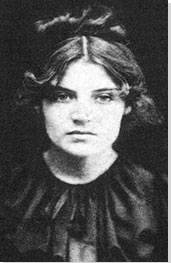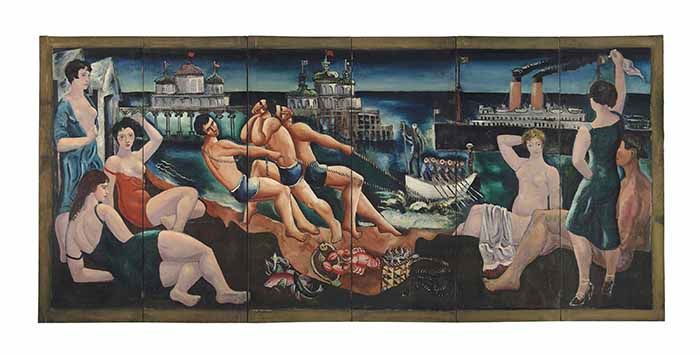Summary of Suzanne Valadon
Typically with a look of defiance and a slight scowl, Suzanne Valadon lived and worked at the absolute epicenter of artistic Paris in its heyday. She was a model and a dear friend to some of the most famous artists of a generation, as well as a groundbreaking artist in her own right. She forged a career in a man’s world, challenged the conventions of the nude, and carved a new critical space in which to consider a woman’s body. Valadon’s portraits are based on real emotions and actual physical experience; they encourage women to look for themselves and to reclaim their own viewpoint. Whilst her technique and observational style have much in common with the French and English Post-Impressionists, her hard hitting and multi-layered thematic edge - a fascinating and central focus on sex and aging - is more akin to that of the German, Austrian, and Scandinavian Expressionists, making Valadon an art historical lynchpin as well as a bright beacon for Feminist Art.
Accomplishments
- Valadon differed from her female contemporaries, Berthe Morisot and Mary Cassatt, who, born into upper middle-class families were restricted in their subjects and outlook. Born to an unmarried mother and educated by street life, Valadon developed the confidence to be independent, to paint more challenging pictures, and to define her own identity outside of the prevailing norms. What seemed like an unfortunate start in life, was potentially a golden ticket into the male-dominated art scene of the time.
- Whether or not it was her intention, Valadon adds food for thought to theoretical debates surrounding the subject of attraction between men and women and the politics of looking addressed later in the century (by the likes of Simone de Beauvoir, John Berger, and Laura Mulvey). There is a very strong sense in all of Valadon’s work that she seeks to demystify sex and to present passion and libido as common experiences shared by all. Women are presented as active equals also in possession of the hungry gaze.
- Not only an artist, Valadon is also famous for her inclusion in so many other artists’ notable works. She doubled as a muse and an artist. She worked for 10 years as a professional artists' model, all the while cleverly gleaning contacts, ideas, and techniques.
- Throughout her career, Valadon returned to self-portraiture. A deep and penetrating awareness of self seemed to flow as a strong wave across the early-20th century and brought with it a heightened awareness of vulnerability and mortality, namely Expressionism. Fellow women artists – including Kathe Kollwitz, Paula Modersohn-Becker, and Helene Schjerfbeck – each explored similar themes.
The Life of Suzanne Valadon
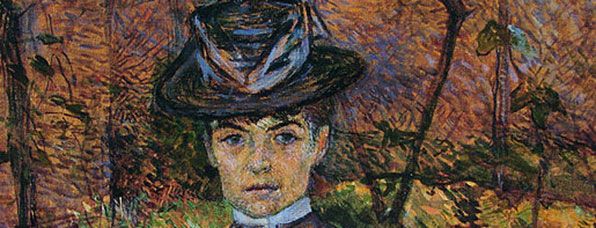
Valadon was central to the art world in France at the time - in this 1885 portrait she is just about 20 years old, and already inspiring the likes of Henri de Toulouse-Lautrec.
Important Art by Suzanne Valadon
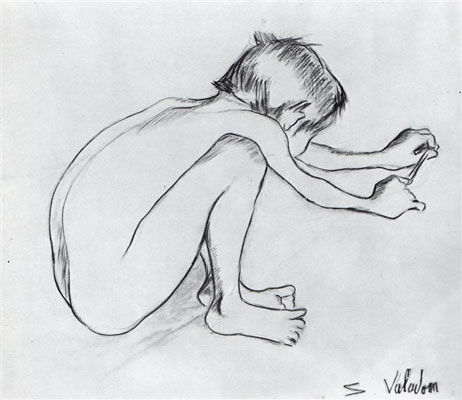
Maurice Utrillo Playing With a Slingshot
As in all of her early drawings, Valadon develops a signature dark outline to her subjects. Unlike other women artists at the time Valadon rejected examples of a light and feathered “feminine” brushstroke, and instead experimented with bold and definitive lines, more typically considered to be “masculine”. Indeed, the style and energy of Valadon’s mark making is most comparable at this point with the work of Egon Schiele. Like Schiele, Valadon was driven by passions from within - an energy and life force. Her initial works are observational, drawings of the scenes that were around her at the time, and in this case the subject is her son.
Depicting one’s children is an interesting way for a woman to combine two roles that are often considered incompatible, that of being a mother and an artist. Kathe Kollwitz did a similar thing and since Valadon, more and more women have drawn, painted, and photographed their children as a way to be artists and at the same time care for their children and maintain domestic balance. Alice Neel painted both her children and grandchildren as available models and thus as a practice born of necessity. What is revealed is very interesting because the genre of portraiture is generally transformed, no longer a vehicle to communicate status and wealth, but rather an opportunity to reflect on identity and the workings of human psychology.
Crayon and paper - Private Collection
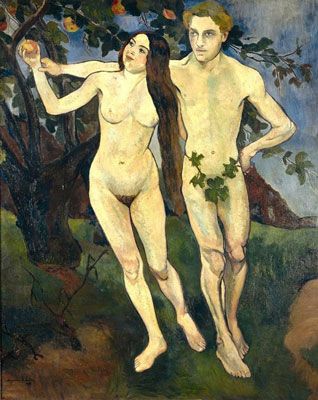
Adam and Eve
This painting was made during a highly productive period for Valadon when she had just met the young André Utter. She had fallen in love again and as such felt a surge in creativity and began to paint rather than draw much more. The nearly life-sized painting depicts Valadon as Eve and Utter as Adam, the original lovers in the paradise of the Garden of Eden. The painting was originally completed without the leaves covering Utter’s genitals, but they were added later in order to avoid scandal and to enable exhibition of the work in the Salon of 1920.
This was the first painting in which Valadon placed her subjects in an outdoor rather than interior setting. It was also the first painting exhibited by a female artist to show a nude man and woman together, and not merely any man or woman, but the artist and her lover (albeit in the guise of religious art). As Hewitt writes, “For a woman to paint a nude heterosexual couple showed extraordinary daring; it was simply not done.” The piece was audacious on a personal level too. The figures poised on the precipice of sin, with Eve/Valadon reaching for the apple, their naked bodies already entwined. Valadon may be referencing her own relationship here - that of an older woman and much younger man - he as the forbidden fruit, and she, with the confidence to take him. Overall, the painting makes the fact that people fall in love and have sex a much more public and real idea than convention at the time. This is not an ideal fantasy, even though presented in a biblical guise; the painting speaks of the meeting of fleshy bodies in a way that prior to this was unheard of.
With the classical pose and luminous sky set against the dark trees, the painting echoes paintings of the same theme done in the early 1500s of Lucas Cranach the Elder, copies of which were readily available to Valadon. There is no serpent in Valadon’s painting, though, and the figures seem weightless, appearing to be floating together. According to Hewitt, “The couple, Suzanne confessed, were caught in a timeless paradise and they were both responsible for their sin." This began a prolific period for Valadon, in which she started to paint more than draw, and to produce more paintings of nudes.
Oil on canvas - Centre Georges Pompidou, Paris
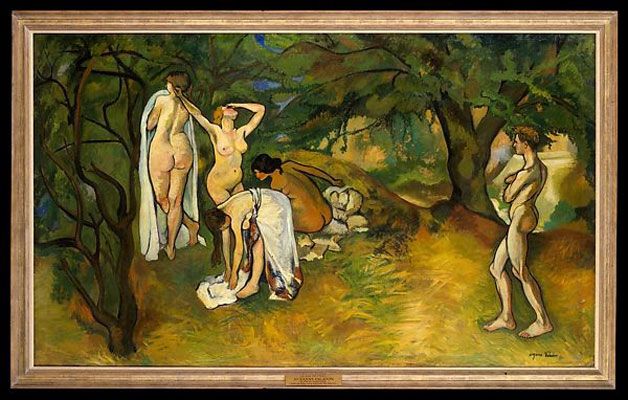
Joy of Life
This is an interesting painting in that it recalls similar scenes by the likes of Cezanne and Matisse. Indeed, bathers in nature or nudes in a landscape has been a time-honored theme for artists, from ancient Greece to 20th-century Paris and beyond. Titian, Renoir, and Paul Gauguin have also painted such a scene and Valadon was familiar with all of these precedents. The main difference in Valadon’s picture stems from her inclusion of the male figure to the side, for which her lover, Andre Utter, was the model. There is a sense once again that this painting seeks to demystify sex and attraction. Previously women in such scenes were portrayed languidly displaying themselves without the pointer as to where and to what the sexy poses would lead. Here there is no mistaking that what we are dealing with - desire, libido, and sex. This is not a painting about fantasy or flirtation, but about the physical yearning for sexual connectivity, importantly experienced by both men and women.
Professor and art historian Gill Perry writes in The Concise Dictionary of Women Artists, “These female figures seem strangely separate from each other, from the male viewer and from the nature that surrounds them. Far from evoking a utopian harmony of woman and nature suggested by, for example, Matisse or Gauguin, Valadon’s robust and sharply outlined women suggest a more ambiguous, dislocated relationship with both nature and the male spectator.”
Oil on canvas - The Metropolitan Museum of Art, New York
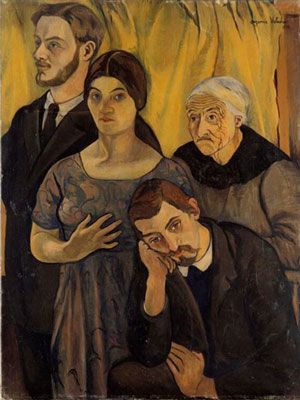
Family Portrait
Here Valadon presents her new and unconventional family having recently moved in with André Utter, whilst still living with her aging mother and notoriously temperamental son, Maurice. Maurice is depicted at the forefront of the canvas in a typical artist/thinker “head in hands” pose. Valadon though is at the center and gestures towards her chest, as though saying to the viewer that now women are making art there is a new way to be the archetypical “artist”; this way is to work from the heart, from the breast, and in other words from a starting point of connectivity and love (not “from the prick” as Renoir was famous for saying). Indeed, Valadon takes on a similar pose to Mary in Virgin and Child masterworks of the Renaissance, therefore subtlety highlighting the heroic powers of motherhood. Valadon stands as the central, strong protagonist in the work.
Whilst the style of painting recalls works being made at a similar time by Vincent van Gogh and more closely, by Paul Gauguin, with Maurice even resembling Gauguin in his own self-portraits, in terms of subject - The Family, and the passage of time through generations and aging – there is an interesting parallel to be made with the Austrian Expressionists, namely with Gustav Klimt and Egon Schiele who both repeatedly depicted small family groupings. What is amazing in this painting by Valadon though, and what is not the case in the traditional father, mother, child triad depictions of family by Klimt and Schiele, is that Valadon subverts traditional expectations. Looking forward to contemporary days, Valadon shows that all combinations of love are possible and that family union can be eclectic and unexpected. She later produced another version of her “family” in which Utter does not feature, but her dog is depicted alongside her mother and son.
Oil on canvas
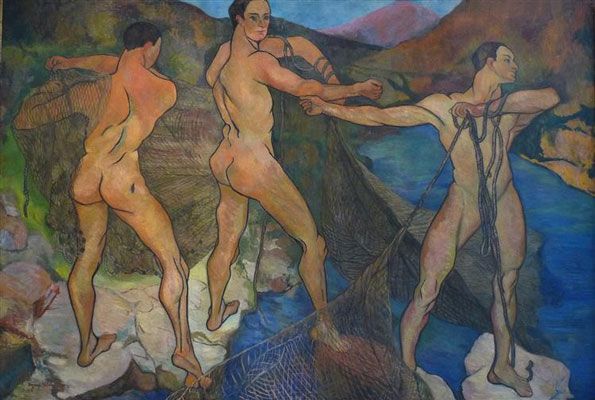
Casting the Net
Completed whilst passionately entwined with the much younger Utter, and in the year that the lovers could finally marry, Casting the Net reflects the states of joy and pleasure that Valadon was experiencing at this time. It is a revolutionary painting even more brazen than previous works in its blatant disregard for societal conventions. The painting depicts three male nudes, whilst the artist – a woman – here has become the voyeur. It is a huge painting, with the figures painted practically life-sized, muscular, all in various poses in the process of casting fishing nets. Utter modeled for the work, while Valadon painted, a very unusual set up for the time.
The scene reminds the viewer of a homoerotic picture by Christopher “Kit” Wood of the same subject, Beach Scene with Bathers, Pier and Ships (1925) and thus confirms that men hauling nets is a particularly sexy event to watch. Valadon seeks to make very clear in this picture that she too experiences pleasure when looking at the male body. In a total reversal of traditional gender roles, the men are objectified whilst the female viewer looks on in fantasy and delight. It becomes almost comical that the rope covers the penis, much like the leaf for Adam in the previous painting and this was likely done so that Valadon would be able to exhibit the work in the 1914 Salon d’Automne.
Oil on canvas - Centre Pompidou - Musée National d'Art Moderne, Paris
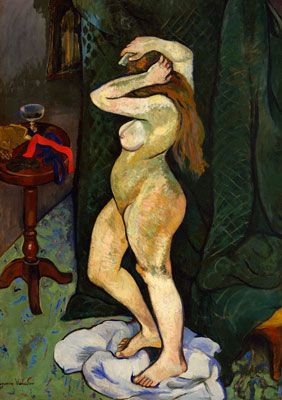
Nude Arranging Her Hair
Here Valadon paints a nude at her toilette, the most common subject of her friend and mentor, Edgar Degas. Valadon’s depiction however does not have the same frills of femininity, neither the same pastel palette, nor the light feathered brushstroke as her “master” (perhaps a term that Valadon coined for her friend with tongue in cheek intention). Valadon’s woman is burly and strong, reminiscent of a tree in her rootedness to the ground. The bright red ribbon strewn over the circular table is a symbol of experience and acknowledges that we are looking at a woman who is no stranger to life and lust.
Valadon often painted women engaged in mundane, everyday activities. This woman is probably Valadon’s housekeeper, Gaby, who worked for Valadon during World War I, and who often modeled for her. Like Alice Neel would also go on to do, Valadon often painted her friends, family, and acquaintances; she painted female nudes throughout her career, as well as male nudes, and nude self-portraits. According to the National Museum of Women Artists description, Valadon was one of only a few women artists during the first half of the 20th century whose primary subject was the female nude. Unlike male representations of women, her paintings of women are unidealized, catering neither to the desires of the male viewer, nor to the vanity of the model, herself, and thus the “nude” always also becomes a “portrait” in the work of Valadon, not only some flesh to be laid eyes upon.
Oil on canvas board - National Museum of Women in the Arts, Washington DC
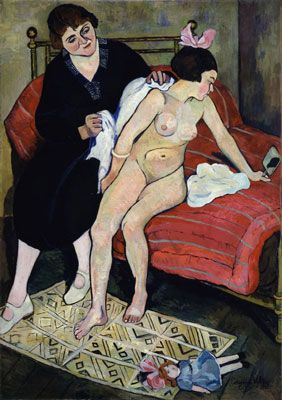
The Abandoned Doll
This is a profound and wonderful painting of a subject otherwise rarely depicted, that of the onset of puberty for a growing girl. Here we are granted privileged insight into the moment of the awkward transition from girl to woman, when the body has matured before the mind has had the chance to catch up; the result is confusion and frustration whereby the figure is caught between an old doll and a new hand mirror. This is a subject not really picked up again in the trajectory of art history until the work of Balthus when the meaning and overall rendering of the subject is very different because expressed from a male viewpoint.
The figures are Valadon’s niece and the girl’s mother, one of two paintings that Valadon did of the duo. According to professor and art historian Nancy G. Heller, “Avoiding the voyeuristic aspect of so many female nudes painted by men, Valadon gives viewers a compassionate glimpse of an intimate moment in a young girl’s life.” As Delese Wear and Lois LaCavita Nixon maintain in Literary Anatomies: Women’s Bodies and Health in Literature (1994), “One has the future before her, while the other is moving toward decline and aging. Valadon's representation of this reality is beautifully portrayed and quickly identified by men and women alike as an integral part of the human experience. Until Valadon and other renegade artists and writers, personal stories about life stage realities had been omitted or excluded from the creative canon.”
Oil on canvas - National Museum of Women in the Arts, Washington DC
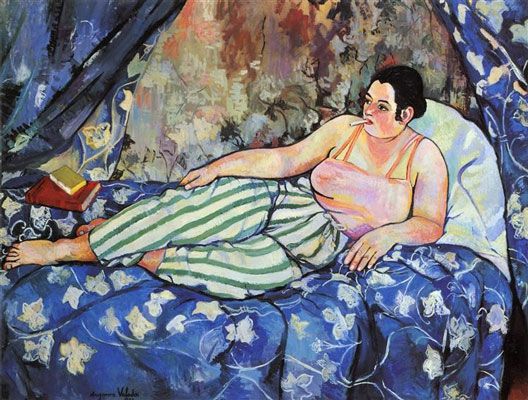
The Blue Room
The Blue Room is one of Valadon’s most famous paintings. Valadon portrays herself as a full-figured, voluptuous, intelligent woman and artist, lounging on an inviting daybed with books close at hand. She is wearing loose green and white striped bottoms, and a salmon pink camisole top that blends with the warm tones of her skin, almost as if she is suggesting nudity, but intentionally is not. A cigarette dangles from her mouth as she gazes off to her right seemingly lost in her own thoughts. Her right arm rests on her hip, and the other casually props herself up against a pillow. She has an air of authority at this point in her career and an overall commanding appearance. The painting shows how relaxed Valadon has now become, both with her own body and with her artistic talents.
Valadon’s pose is based on art historical precedents and as such makes the canvas particularly significant. It is reminiscent of classical Renaissance nudes, such as Titian’s Venus With an Organist and Cupid (1549), which idealized the female body as primarily seductive. The painting is also, and more interesting in comparison, similar to Edouard Manet’s 1863 painting, Olympia. The composition is very similar but once again Manet’s female nude is sexually available, whilst Valadon is self assured and content with a strong sexuality that makes up only part of a much more complex and multi-faceted character. She is a post-World War I, modern, working-class woman who dresses as she pleases - even wearing pants and smoking, traditionally male activities - and furthers her intelligence through reading.
Valadon’s mastery of color and form in this picture is exquisite. Whilst the blue and white floral fabric in the foreground is reminiscent of the work of Matisse and Gauguin, the sheet in the background is much more loosely and suggestively rendered, so much so that it becomes entirely abstract and as such acts as a precursor to future artistic directions.
Oil on canvas - Centre Pompidou - Musée National d'Art Moderne, Paris
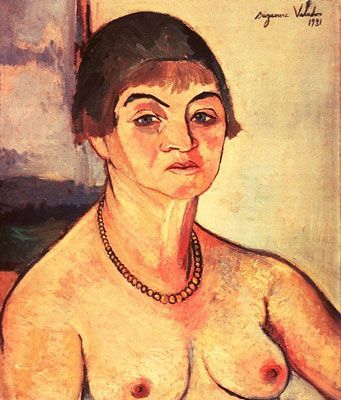
Self Portrait with Naked Breasts
This self-portrait by Valadon is remarkable in that it unites two previously separate genres, the nude and the self-portrait. There is only Paula Modersohn-Becker who had done this before her in Self Portrait on my 6th Wedding Anniversary (1906) in which the artist, interestingly, also wears nothing but a necklace. Both are iconic self-portraits, extremely realistic and honest. Whilst Modersohn-Becker was young when she painted herself bare-breasted however, Valadon here is aging, and therefore as in her work on the representation of puberty, she once again highlights an important but nevertheless overlooked aspect of the journey through womanhood. Alice Neel did a similar self-portrait in 1980 when she was 75, and the English painter, Jenny Saville, would also go on to focus on bigger, “non-idealized” bodies. Like Valadon, both Saville and Neel recognize that it is the wrinkles and the sagging flesh that make a body interesting; they give a body life and proof of its journey.
It may have been because of Valadon’s extensive experience as a model, as well as an artist drawing from the nude, that she really did understand that every body was different and to highlight this was, in many ways, the strength of the portrait genre. Valadon made two self-portraits showing at once her naked breasts and her signature look of seriousness, one at age 59 and then this one at age 67. It was remarkable to do this at this time, and still today for that matter; Valadon asserts her own view of her own body, not restricted by youth, and still active, present, and working well into later life. Indeed, in this picture Valadon entirely ruptures an ideal: whilst previously nudity had signified sexual availably, Valadon’s nude is much more about identity, about painting the self uncovered and unrestricted in order to further and strengthen one’s own personal development (and possibly to inspire others to do the same).
Oil on canvas - Collection Bernardeau, Paris
Biography of Suzanne Valadon
Childhood 1865-1880
Suzanne Valadon was born Marie-Clémentine Valadon in 1865 in Bessines, France to an unwed washerwoman, Madeleine, and never knew her father. The event of her birth immediately labeled her as marginalized, transgressive, and rebellious; these were the characteristics that Valadon embraced and transformed to become positive as she developed as a person and as an artist.
When Valadon was five years old her mother took her and her half-sister to live in Paris with their aunt in order to escape the stigma of being an unwed mother. It was a time of great political unrest, and Madeleine decided to move the family to Montmartre, a lively small area that had managed to retain a certain village-like quality and as such reminded her of home. It was known as the bohemian quarter of Paris, where artists, prostitutes, pimps, and other creative and unusual characters lived. The family felt at ease here, and Valadon grew up roaming the streets and creating mischief, while her mother worked as a housecleaner. According to Catherine Hewitt, author of Renoir’s Dancer: The Secret Life of Suzanne Valadon, Valadon reported later, “The streets of Montmartre were home to me … It was only in the streets that there was excitement and love and ideas - what other children found around their dining-room tables.” She also called herself a “devil” typically behaving more “like a boy,” and was lucky in many ways, in that she said, “solitude suited me.”
Valadon was notably stubborn, independent, and hot tempered from a young age. Yet she was also sensitive, fun loving, charming, full of energy, and well liked. She was attractive, with big blue eyes and golden-brown curls framing her face. Her imagination was vivid and she sometimes told stories to suit her needs, regardless of veracity or logic, one of which was that the 15th century poet, François Villon, was her father. Later she would also lie about her age at times, always determined to create the life that she wanted rather than accept a somewhat lesser or expected reality thrust upon her.
As a young child, Valadon had also already demonstrated an avid interest in art and could draw relatively well by around the age of eight. She would draw on any scrap of paper she could find, on the walls at home, and even on the pavement, often with only the stub of a pencil, or sometimes a lump of coal. Her subjects varied widely, but were often those that she observed and found interesting in her immediate environment including flowers, trees, cats and dogs, and, of course, people.
Valadon started working odd jobs to help support her mother financially by the age of 11 after attending school at a nearby convent for only a short time. At the age of 15 she became an acrobat in the popular Molier circus, a job that Valadon instantly loved. Unfortunately she had only worked at the circus for six months when she fell from the trapeze, injured her back and thus ended her career. It was a devastating blow for the young Valadon to have to leave the circus, a sadness she maintained forty years later saying that she would never have willingly left had it not been for her injury. After leaving however, as though destiny had intervened, her energy had to be channeled elsewhere; at this moment she immersed herself wholly within the art world.
Early Training and Work
Valadon strived to become a serious artist, but unlike her contemporaries Mary Cassatt, Berthe Morisot, Eva Gonzalès, and Marie Bracquemond she could not afford art lessons. She therefore turned to modeling as a way to get close to and learn from the artists she admired, even though modeling, especially in the nude, was not considered a respectable occupation. She modeled for ten years, starting at age 15. Some of the artists for whom she posed, and was perhaps also a mistress/lover for a time, included Puvis de Chavannes, Pierre-Auguste Renoir, and Henri de Toulouse-Lautrec. Without realizing it at the time (or maybe she did, we cannot know), it was through modeling that Valadon carved a unique journey for herself as an artist. As a woman painting at the time, she gained privileged backdoor access to the most influential and exciting developments in art, in a way that other female artists did not. She managed to transform what one may mistakenly assume to be a disrespect through modeling into a heightened respect from her male peers.
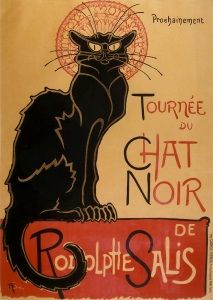
As she matured, Valadon frequented many of the cafés springing up in 1880s Paris and enjoyed the entertainment and camaraderie that she found there. Le Chat Noir became a notable favorite for Valadon, as it was for many of the Impressionist painters, as well as other avant-garde musicians, artists, and writers working at the time. Valadon, feeling at home among creative and passionate individuals, was happy and popular. She engaged in all sorts of fun escapades, including sliding down the banisters at the Moulin de la Galette wearing only a mask.
Valadon met Miguel Utrillo at Le Chat Noir in 1880 when she was 15 years old. He was three years her senior and there was an immediate attraction between them. Hewitt writes that Valadon said about their relationship, “At a time when barely anyone paid me any attention, he encouraged me, strengthened me and supported me…. with Michel (Miguel) I spent the best years of my youth…. we lived an artistic and bohemian life.” When Utrillo moved away from Paris two years later, the couple continued to keep in touch. Their relationship, as passionate as it was, was not exclusive. When Valadon, at age 18, gave birth to her son, Maurice, Utrillo gave the baby his name, and signed the birth certificate as his father although it was never entirely certain that this was the case. Maurice was taken care of principally by Valadon’s mother so that Valadon could continue working as a model and earn money.
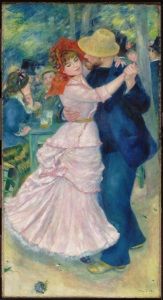
Both at the time, and continuing to this day there is speculation that the father of Valadon’s baby may have been Renoir as Valadon was modeling for him frequently in 1882 when she became pregnant. At that time Renoir was 40 years old and one of the most famous artists in Paris. Renoir loved using Valadon as his model and she appears in several of his well-known paintings including - Dance in The City (1883) and The Bathers (1884-87). In another painting, Dance at Bougival (1883), the woman featured is thought to be an amalgamation of Valadon and Renoir’s wife, and therefore perhaps his ideal woman. Valadon modeled for Renoir from age 17 until she was 22.
Soon after giving birth to Maurice, Valadon met Henri de Toulouse-Lautrec and also became his model, as seen in The Hangover (1889), as well as his lover for a time. Toulouse-Lautrec was the person in her life who persuaded her to change her name from Marie-Clémentine to Suzanne, comically making reference to the biblical story of Susanna and the Elders, since Valadon liked modeling for older artists. He was kind and encouraging to Valadon and so impressed by her drawings that he introduced her to Edgar Degas, another artist who became a close friend, and as her career developed, her most influential artistic mentor.
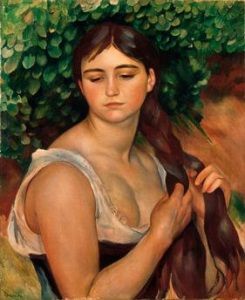
Her friendship with Degas blossomed quite surprisingly because he was generally known to be reclusive and it was unusual for him to make a new friend, although it is well known that he was also connected to Berthe Morisot for a time. Like Toulouse-Lautrec, Degas also recognized Valadon’s talent from the outset, poignantly saying, upon seeing her work “you are one of us.” He encouraged and tutored her, bought some of her artwork, taught her etching on his own press, and had an enormous influence on her confidence and artistic development. In return, Valadon referred to Degas as “the master” and showed him unwavering respect and considerate friendship until his death.
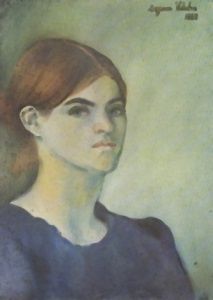
Some of Valadon’s first-known works on paper are dated 1883, including a commanding and accomplished pastel self-portrait. It is thought that she drew her first female nude around 1892 and that she made mostly pastel and charcoal drawings until the following year, mainly of her son and family. Her first known oil painting is from a similar year, but even after adding the medium of oil paint to her repertoire she continued to prefer drawing because paints were hard to obtain and she had to mix her own. She said, ”I was so wild and proud that I did not want to paint. … I tried to make my palette so simple that I wouldn’t have to think about it.“
As a burgeoning artist, Valadon showed five drawings at the Salon of the National Society of Fine Arts in 1894; she was historically the first woman painter to ever have work admitted. In 1895, she exhibited 12 etchings of women in various stages of their toilette (heavily influenced by Degas) and began to regularly show at the Galerie Bernheim-Jeune in Paris.
In 1892 Valadon had an intense six-month love affair with the composer Erik Satie while she was also simultaneously seeing a wealthy stockbroker Paul Mousis. Eventually the relationship with Satie ended as Valadon refused to commit to him or to end the relationship with Mousis.
Mature Period
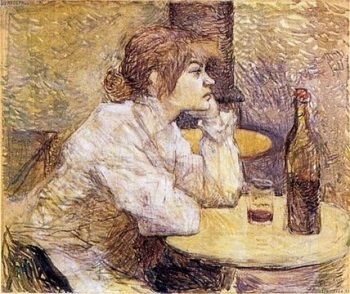
In 1896 Valadon married Mousis and moved her family – including her mother and son - to his house in Montagny, north of Paris. Mousis also continued to rent a small apartment and studio in Montmartre for Valadon so that she could often return to the city. Finally, no longer having to work for a living, Valadon could paint full time. She and Mousis were married for 13 years, during which time she lived a comfortable bourgeois life. Her drawings and etchings started to sell at the gallery Le Barc de Boutteville, and the art dealer, Ambroise Vollard started to publish her prints. She primarily continued to draw and paint women engaged in everyday activities such as bathing. Although these scenes were relatively common as depicted by Valadon’s male contemporaries, it remained unusual and even shocking for a female artist to paint nudes, especially as these images of women were generally truthful rather than idealized representations.
Now a young man, Maurice suffered from depression, wild rages, and alcoholism. A doctor suggested that painting might be good therapy for Maurice so Valadon started to devote time to this and give him lessons. Initially reluctant, Maurice quite quickly began to show real talent. Despite a new focus, Maurice remained a turbulent personality and from 1904 (around age 20) he committed a series of violent episodes and as such was often arrested. In many ways, this was a difficult phase in Valadon’s life. In 1901 she learned of the premature death of her friend, Toulouse-Lautrec, at the age of 37. She encouraged her son to focus on painting and gradually Maurice grew to enjoy his mother’s tutelage and became very accomplished.
In 1909 Maurice met and befriended another young artist called André Utter. Utter was then 23 years old and thus three years younger than Maurice. Despite a more than 20-year age difference Utter and Valadon soon became lovers. Valadon’s marriage to Mousis had become troubled and she felt confined by the lifestyle of a country wife. Valadon therefore left Mousis and she, Utter, Maurice, and Valadon’s mother all lived crowded together with her dogs, cats, and a goat in the small apartment in Montmartre. In 1910, Mousis filed for divorce but allowed Valadon and her unorthodox family to live for a while in the small house he had built in Montmagny, just North of Paris, where Valadon, Maurice, Utter became known as the “terrible trio” by more “proper” members of society because of their unusual living arrangement.
Valadon wrote later that meeting Utter was a “renewal of her life.” In 1909, with Utter’s encouragement, she began to paint more than draw, and her creativity once again exploded along with her romantic life. She focused even more on nudes and sexual pleasure in her art. She painted Adam and Eve (1909) (in which she and Utter are naked), Joy of Living (1911), and Casting of the Net (1914).
Valadon had her first solo exhibition in 1911 at the gallery of Clovis Sagot, followed by regular inclusion in the Salon d’Automne and the Salon des Independents, as well as multiple showings by Berthe Weill, the only female art dealer in Paris at the time and a steady supporter of women artists.
Late Period
Utter and Valadon got married in 1914, shortly before World War I began, and after a divorce from Mousis had been made official. After serving in the army Utter returned and became both Valadon and Maurice’s business manager. Her confidence and productivity once again peaked when Utter returned and she produced a number of paintings, including nudes, landscapes, portraits, and still lifes. This was achieved despite continual struggles with her son’s mental health, and bereavement over the deaths of some of her greatest friends - Degas in 1917, Renoir in December 1919, and Amadeo Modigliani in 1920.
When the war ended Maurice’s landscape paintings were also in increasing demand and started to sell for higher prices. Valadon’s reputation continued to rise well into her sixties and she was well respected amongst her peers and critics. Somewhat frustratingly though, her paintings never commanded as much money as did those of her son. In 1920, Valadon was elected a member of the Salon d’Automne and there was an outpouring of praise for her solo show in December 1921. Art critic Robert Rey wrote, “The painting of these noble nudes is so clean, so clear, so natural, the colors so bold, the line always expressive … I want to say and repeat that Suzanne Valadon is a very great artist, on a level at least equal to Berthe Morisot.” Another wrote, “this extraordinary woman breathes life into everything she paints; [she] is passion itself and one seeks in vain to find someone to whom she can be compared.” Valadon was included in a scholarly art journal published in 1922 that praised her for her “fine courage.” She was not however, universally admired. According to June Rose, author of Suzanne Valadon: Mistress of Montmartre (1998), gallery owner Berthe Weill “commented on Valadon’s growing ability but noted that she had many detractors.” Rose writes that “she could be offhand and dismissive to both critics and buyers,” but was a “great artist.”
Valadon was never labeled to be part of any formal school or movement. According to John Storm, author of The Drama of Suzanne Valadon (1958), “to her, art was an expression of private passion, uncomplicated, and irrational. Its theories were imposed by nature, not by group thinking. ‘Above all,’ she was to say later, ‘I believe that true theory is the one imposed by nature first on the painter and then on what he sees.’”
Utter and Valadon’s romantic relationship began to deteriorate likely due to the stress of dealing with Maurice’s erratic behavior, and jealousy. Their circumstances changed however, and the load lightened slightly, when Parisian art dealer Bernheim-Jaune offered to pay Valadon and Maurice jointly a million francs in return for an agreed amount of work. This was a financial windfall, and Valadon immediately bought an old chateau in Villefranche-sur-Saone with the money. Henceforth, Valadon, Utter, and Maurice would spend summers in the new chateau and winters back in Montmartre. Valadon was generous with her money, always giving extravagant gifts and tips to those whom she felt needed it. Her paintings of the time, with patterned carpets, rich drapes, and tablecloths, reveal the prosperity of the milieu of which she was now a part.
By the late 1920s it was Maurice’s paintings that sustained a primary income for the family. Valadon's physical appearance began to show the effects of aging as she moved through her 60s, but she continued to paint daily, figures that were more and more truthfully rendered.
By the age of 70 Valadon’s health was failing and she made extended visits to the hospital. During one hospital visit, an old friend, Lucie Pauwels, offered to take care of Maurice. Soon after Maurice and Lucie were married, and in many ways Valadon felt as though she lost her son. She was jealous of Lucie and worried that she was only interested in the money that Maurice had accumulated. By this point Valadon was quite alone, long since separated from Utter.
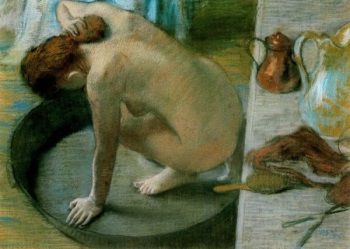
Despite missing the men in her life, Valadon continued to paint and exhibit, making more landscape and still life paintings in the final years of life. She showed regularly at the Salon des Femmes Artistes Modernes between 1933 and her death. In 1937 the state bought many of her paintings, and she sold three major paintings and several drawings to the prestigious Musée de Luxembourg. She impressively had nineteen exhibitions between 1913 and 1932, and four major retrospectives before her death.
On the morning of April 7, 1938, she was painting flowers at her easel when she had a stroke and died. She was not wealthy at this point, being too proud to accept money from her son and his wife. She was buried beside her mother in the cemetery at Saint-Ouen, in the northern suburbs of Paris. André Derain, Pablo Picasso, and Georges Braque were some of the notable artists who attended Valadon’s funeral along with many others. By the time of her death, Valadon had made around 300 drawings, over 450 oil paintings, and more than 30 etchings.
The Legacy of Suzanne Valadon
Due to the combined quality of her artwork and groundbreaking treatment and representation of the female nude Suzanne Valadon is considered one of the greatest early female artists. As muse to many of the most famous Impressionists, as well as an artist often making self-portraits she is one of the most well-documented and “seen” French artists. Thus she has become an important role model for following generations of female artists. Janet Burns writes in her paper, Looking as Women: The Paintings of Suzanne Valadon, Paula Modersohn-Becker, and Frida Kahlo (1992), “Given the bias of western culture to fetishizing the female body, the nude is a difficult genre for women artists. It is enshrined as an icon of culture that epitomizes and objectifies female sexuality. For these reasons it is resistant, although not impervious, to change.” Valadon was one of a handful of pioneering female artists who not only successfully transitioned from being an artist’s model to becoming an artist, but also succeeded in challenging the traditional male voyeuristic gaze.
It was of course the case that women had depicted themselves in art before, but Valadon’s combination of the self-portrait and the nude was revolutionary with only Paula Modersohn-Becker known to have done this before her. After Valadon, many younger artists were inspired by her paintings of female nudes, and particularly those which were most realistic, with wrinkles and sagging and all. Alice Neel certainly embraced the same energy and agency and made aging self-portraits comparable to those of Valadon. Neel also inherited Valadon’s intense black line, saturated color palette, and love of painting her own children. Both artists successfully revealed the complex psychology present in their sitters, honoring them as people to be considered, rather than objects to be possessed. The British artist Jenny Saville, remembered for her depictions of very large fleshy nude self-portraits, was also likely guided by the new space of active women looking at themselves opened up by avant-gardes like Suzanne Valadon.
Influences and Connections

-
![Henri de Toulouse-Lautrec]() Henri de Toulouse-Lautrec
Henri de Toulouse-Lautrec -
![Edgar Degas]() Edgar Degas
Edgar Degas - Miguel Utrillo
- André Utter
 Ask The Art Story AI
Ask The Art Story AI